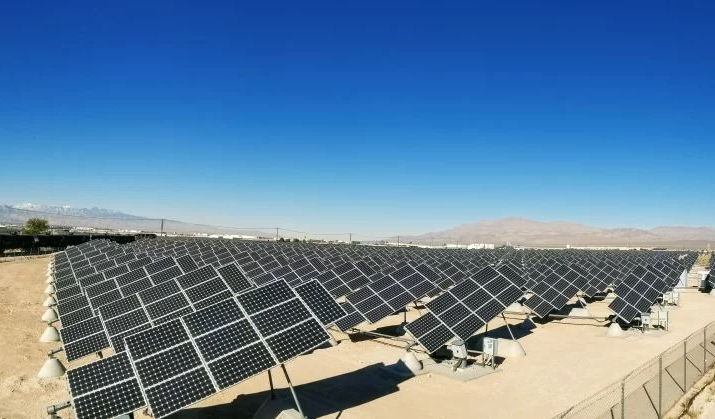
The new projects are part of NV Energy’s integrated resource plan approved Wednesday by the Public Utilities Commission of Nevada. NV Energy announced the projects in June with developers 8minute Solar Energy, EDF Renewables, Quinbrook Infrastructure Partners and Arevia Power, and it expects them to be online in 2023.
This massive solar procurement includes Quinbrook and Arevia’s newly approved Gemini project, at 690 megawatts, which is tied with the Misae 2 project in Texas as the country’s largest single solar PV array. 8Minute’s 300-megawatt Southern Bighorn project and EDF’s 200-megawatt Arrow Canyon project complete the solar portion of the procurement.
All three projects will also come with at least four hours of energy storage capacity to shift hundreds of megawatts of solar power from peak midday output into later in the afternoon or evening. Gemini’s 690 megawatts of solar will be matched by a 380-megawatt battery array with about 1.5 gigawatt-hours of storage capacity. That could make it the biggest solar-paired utility storage projects in the country, as compared to the previous record holder, the 409-megawatt/900-megawatt-hour Manatee Energy Storage Center being built by NextEra Energy’s Florida Power & Light.
8Minute Energy CEO Tom Buttgenbach noted in June that the Southern Bighorn project, which will match 300 megawatts of solar with a 135-megawatt/540-megawatt-hour battery system, could run 65 percent of the time during peak summer hours, as opposed to the roughly 30 percent availability of the average solar plant in Nevada. The Arrow Canyon project offers an even more extended 5-hour storage duration, pairing 200 megawatts of solar with a 75-megawatt/375-megawatt-hour battery array.
These lengthening megawatt-hour figures for NV Energy’s latest solar-storage power-purchase agreements reflect a trend for longer-duration storage across the country, as falling battery prices allow for more cost-effective shifting of solar production. They’re also important for states like Nevada and Arizona that are starting to see the same "duck curve" effects as nearby California, where solar generation is pushing cheap energy onto the grid at midday that fades away in the evening hours when electricity demand spikes.
NV Energy, which provides about 81 percent of Nevada's electricity, is seeking to double its renewable energy capacity between 2018 and 2023, and meet a new 50 percent by 2030 renewable portfolio standard passed this year. This year’s procurement, along with power-purchase agreements for more than 1 gigawatt of solar and 100 megawatts of storage procured in 2018, “puts NV Energy really far down the path toward meeting its renewable energy portfolio targets,” according to Colin Smith, a Wood Mackenzie Power & Renewables senior solar analyst.
“There are only a handful of utilities that can really claim they’ve gotten to 50 percent renewables,” Smith noted. But with Nevada recently joining the growing list of states with 100 percent clean energy goals and mandates, “now they’re reaching the question of how much harder it will be to hit 60 percent, 70 percent, 80 percent.”
Other Berkshire Hathaway utilities are also turning to solar paired with storage as the most cost-effective option for their future energy needs.
PacifiCorp, the 1.9-million-customer utility serving six states from Oregon to Wyoming, has filed an integrated resource plan that calls for nearly 3,000 megawatts of solar and 600 megawatts of battery storage by 2025, alongside about 3,500 megawatts of new wind power and a significant amount of natural-gas-fired generation.
Meanwhile, Buffett's MidAmerican Energy utility in Iowa is on track to generate renewable energy equal to 100 percent of its customers' needs by the end of 2020, following a multi-gigawatt wind farm building spree.